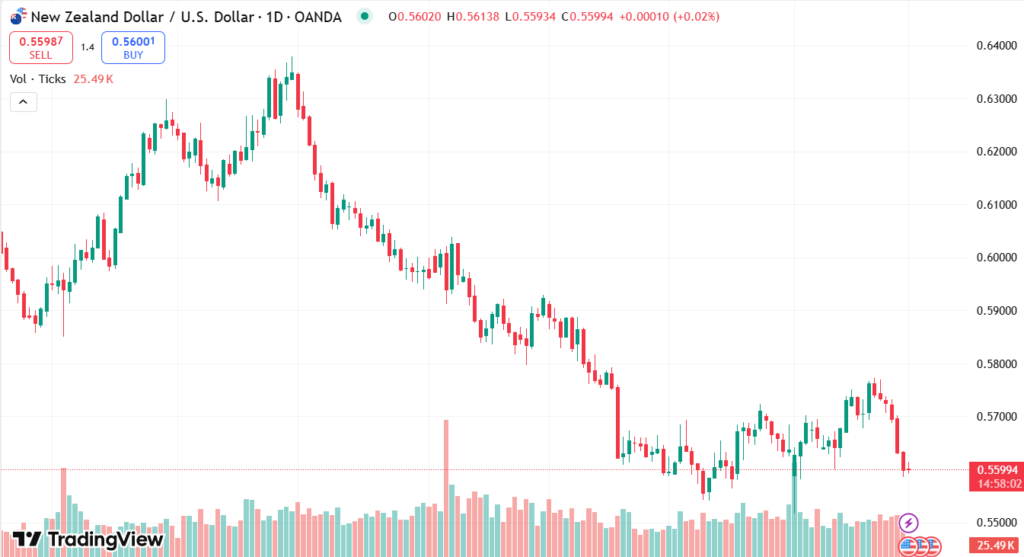NZD/USD is stable at 0.5600 following a recovery from recent losses on the back of slowing US inflation fears and improved economic data in China. The US Dollar lost ground following January’s PCE inflation figures in line with expectations, cutting back on the risk of surprise inflation spikes. In addition, China’s Caixin Manufacturing PMI increased to 50.8, beating expectations and pushing up the New Zealand Dollar. Nonetheless, there is limited upside potential for the NZD with increasing global trade tensions, as President Trump declared an additional 10% tariff on Chinese imports, effective next Tuesday, and new tariffs on Canadian and Mexican imports.
KEY LOOKOUTS
• USD’s direction hinges on future economic indicators and Federal Reserve cues, with increasing Treasury yields potentially capping further losses.
• Increased Chinese PMI data favors the NZD, but any Chinese economic slowdown could pressure the currency pair.
• President Trump’s additional tariffs on imports from China, Canada, and Mexico can contribute to increased market volatility and affect risk-sensitive currencies such as the NZD.
• The future interest rate and inflation trend decisions of the Fed will determine the strength of the USD against the NZD.
NZD/USD remains in focus as multiple factors shape its movement, including US inflation trends, China’s economic performance, and escalating global trade tensions. The US Dollar weakened after January’s PCE inflation data met expectations, but rising Treasury yields may limit further downside. Meanwhile, stronger-than-expected Chinese PMI data provides support for the NZD, reinforcing optimism about China’s economic recovery. Yet, the duo is confronted with headwinds from revived trade tensions, as President Trump imposed additional tariffs on Chinese, Canadian, and Mexican imports, which would add to market uncertainty. Investors will keenly observe future economic data and Federal Reserve cues for further guidance.
NZD/USD stabilizes at 0.5600 as declining US inflation worries and improved Chinese PMI data buoy the pair. Nevertheless, increasing global trade tensions could cap further gains.
• The pair fluctuates around 0.5600 after ending a six-day slide, buoyed by softening US inflation concerns and robust Chinese economic data.
• January PCE inflation numbers came in as expected, cutting short fears of surprise inflation rises and weakening the US Dollar.
• China’s Caixin Manufacturing PMI gained to 50.8, beating expectations, and supporting the New Zealand Dollar.
• The US Dollar Index (DXY) falls after its third consecutive win, but steepening Treasury yields could cap any further decline.
• President Trump launched an extra 10% duty on Chinese goods from Tuesday, ratcheting up trade war tensions.
• Trump’s tariffs of Canadian and Mexican products, slated for March 4, also have the potential to create another layer of currency market uncertainty.
• Investors expect future Federal Reserve cues and economic indicators to get a sense of the strength of the USD vis-à-vis the NZD.
NZD/USD continues to be under the spotlight as economic events worldwide influence sentiment. The allaying of US inflation fears has taken uncertainty off the table, while encouraging Chinese economic data has enhanced optimism around the New Zealand Dollar. China’s Caixin Manufacturing PMI recorded expansion, an indication of stability in one of New Zealand’s major trading partners. This is a vote of confidence for optimism around trade and economic activity, which has an important role in determining the outlook for the NZD.
NZD/USD Daily Price Chart

Chart Source: TradingView
Nevertheless, geopolitical and trade tensions remain a primary concern. President Trump’s announcement of imposing more tariffs on Chinese imports and new tariffs on Canadian and Mexican products has heightened concerns regarding the possible disruption in international trade. Such actions have the potential to affect investor sentiment and shape market trends. With the changing global economic environment, market participants will pay close attention to trade dynamics and economic metrics for more information.
TECHNICAL ANALYSIS
NZD/USD is steadying at the 0.5600 level after ending its recent losing run. The pair has resistance at 0.5630, while near-term support is at 0.5580. A break above resistance could confirm further upside momentum, while a fall below support might suggest fresh selling pressure. The 50-day moving average is bearish, with momentum indicators such as the RSI fluctuating in a neutral range, indicating consolidation. Traders will be watching price action closely to see if the pair can form a more solid trend in the next sessions.
FORECAST
NZD/USD could have potential upside if bullish sentiment on China’s economic recovery continues to drive the New Zealand Dollar. Improved Chinese PMI readings and better global risk appetite might push demand for risk-sensitive currencies such as the NZD. Also, if the US Dollar continues to be under pressure amid fading inflation worries and hopes of a less hawkish Federal Reserve, NZD/USD may have room to appreciate further. A break above pivotal resistance levels could reinforce bullish momentum, driving the pair upward in the short term.
On the negative side, escalating global trade tensions threaten NZD/USD’s stability. President Trump’s recent move to impose higher tariffs on Chinese, Canadian, and Mexican imports may keep financial markets in uncertainty, potentially pushing the US Dollar even higher as a safe-haven currency. Moreover, if US Treasury yields continue their upward trend, they might cap further USD weakness, limiting NZD/USD’s upside potential. A breakdown below key support levels might lead to further losses, prompting traders to go cautious.







